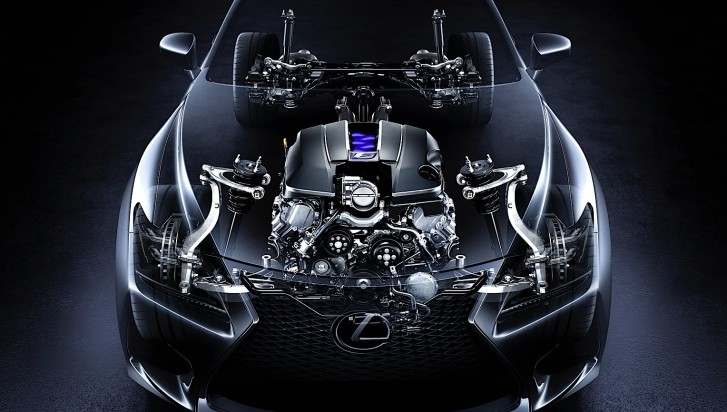The Lexus RC F just made its debut at the 2014 NAIAS in Detroit today and along with its superb styling, which we hope the automaker will use on the production version, the performance coupe also comes with new technological upgrades.
Lexus was still reserved with the details over the upgraded 5-liter V8 engine, but it’s known that it will be the most powerful one until now, boasting over 450 hp and 383 lb-ft (519 Nm) of torque.
Another new addition to the package is the retuned 8-speed Sports Direct Shift gearbox with steering-mounted paddle shifters, that will send the power to the rear wheels through a Torque Vectoring Differential (TVD), also a new technology that will be used for the first time into a Lexus vehicle to make it even more enjoyable.
“I've built RC F to be enjoyed by all enthusiasts – no matter what their level of expertise,” said RC F chief engineer Yukihiko Yaguchi. “There's a misconception that racing cars are hard to drive. In fact, they're easy in the right hands because they've been purpose-built for the skill level of their drivers. It's the same with RC F. Electronics can be modified instantly on board to provide appropriate levels of performance and protection. But even at its basic setting, it's a blast.” he added.
And what Yaguchi-san said in the last proposition, is directly targeted at the new engine’s special capabilities and the TVD’s functioning modes.
Starting with the engine, it will be able to function using the Atkinson cycle at cruising speeds and relatively low rpms, so that the fuel economy will be increased. But then, if you want to go faster and crank up the rpm, the engine will resume to its normal Otto cycle.
Moving over to the TVD, it will offer three operating modes:
Handling will be also improved by making good use of body rigidizing techniques, like large cross-section rocker panels, very stiff front lower brace, strong body adhesives, laser-screw welding, laser brazing and multi-spot welding. More grip will be coming from wider 19-inch wheels and a coil-spring independent suspension, with monotube gas-filled shock absorbers and ball-jointed stabilizer bars.
Another new addition to the package is the retuned 8-speed Sports Direct Shift gearbox with steering-mounted paddle shifters, that will send the power to the rear wheels through a Torque Vectoring Differential (TVD), also a new technology that will be used for the first time into a Lexus vehicle to make it even more enjoyable.
“I've built RC F to be enjoyed by all enthusiasts – no matter what their level of expertise,” said RC F chief engineer Yukihiko Yaguchi. “There's a misconception that racing cars are hard to drive. In fact, they're easy in the right hands because they've been purpose-built for the skill level of their drivers. It's the same with RC F. Electronics can be modified instantly on board to provide appropriate levels of performance and protection. But even at its basic setting, it's a blast.” he added.
And what Yaguchi-san said in the last proposition, is directly targeted at the new engine’s special capabilities and the TVD’s functioning modes.
Starting with the engine, it will be able to function using the Atkinson cycle at cruising speeds and relatively low rpms, so that the fuel economy will be increased. But then, if you want to go faster and crank up the rpm, the engine will resume to its normal Otto cycle.
Moving over to the TVD, it will offer three operating modes:
- Standard for a balance of nimble performance and stability;
- Slalom for emphasis on nimble steering response; and
- Track to help with consistent stability, ensuring the vehicle stays on the intended corning line as the driver applies more throttle.
Handling will be also improved by making good use of body rigidizing techniques, like large cross-section rocker panels, very stiff front lower brace, strong body adhesives, laser-screw welding, laser brazing and multi-spot welding. More grip will be coming from wider 19-inch wheels and a coil-spring independent suspension, with monotube gas-filled shock absorbers and ball-jointed stabilizer bars.


